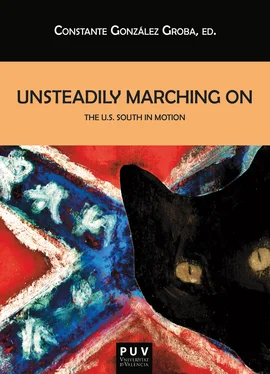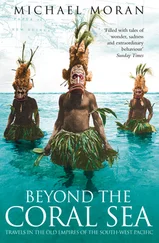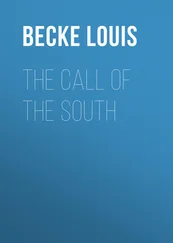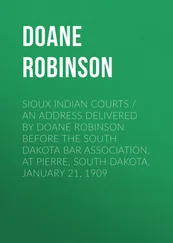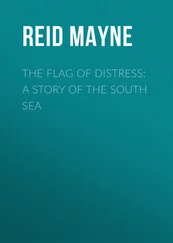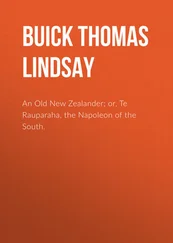One of the South’s most famous fictional “pilgrims” is Will Barrett, the protagonist of Walker Percy’s The Last Gentleman , a novel which keenly explores the individual psyche. In his essay, Gérald Préher traces Barrett’s journey in space (North to South) and time (from the present to the family past), a personal journey that in some respects parallels the journeys of a region which is experiencing the beginnings of the civil rights movement. Percy’s characters are plagued by an intense awareness of their dislocation in a world from which they feel permanently estranged. Barrett has set out on a perilous journey to selfhood and needs to understand the voices of his past in order to gain access to the present, and he is not ready to face the world until he thinks he understands himself. In a novel that tests the idea that the South provides the only remedy to the modern malaise, Will Barrett reluctantly faces the hidden past – what Préher calls “the heart of his father’s darkness” – in the attic of his former house, where the past and the present overlap. As Préher aptly concludes, “The aim of the pilgrimage is to bring [Will Barrett] salvation, and the one who cannot feel the change would be – to use Percy’s expression – forever ‘lost in the cosmos.’”
Thomas Bjerre’s paper focuses on the presence of the South in the genre of 9/11 fiction. While most of the novels about 9/11 have focused only on New York, two novels have used the South in a significant way. Reynolds Price’s The Good Priest’s Son (2005) and Jay McInerney’s The Good Life (2006) contrast frenetic traumatized cosmopolitan New York with a laid-back South still unspoiled by modernity. In both novels the traumatized protagonists find liberation from the chaos of the wounded metropolis in the tranquility of the small-town South, where they temporarily escape the 21 stcentury. Bjerre maintains that while these two novels are realistic depictions of the aftermath of 9/11, their view of the South appears to perpetuate the stereotypes that have always trivialized the region; that, if the modern world is falling apart, the South is fortunately not a part of it.
Undoubtedly the dominant living southern writer, Cormac McCarthy is famous for his opening of new paths in southern fiction after moving west to create masterpieces of the western, and for his creation of heavily burdened travelers that quest for meaning in a violent and dark world. Consequently he attracts the attention of scholars interested in literary movements as well as in the physical and mental displacements of his characters. In the first essay of section II, Robert Brinkmeyer sees McCarthy’s vision of craft and making as possibilities for redemption at the center of a dark and disintegrating world. Following Edward-Lucie Smith’s definition of craft as a calling requiring special skill and knowledge, and the simultaneous engagement of thinking and making, Brinkmeyer argues that the commitment and dedication of the craftsman to his calling, characterized by meaningful work, stands as an important creative antidote to the destructive power and greed that dominate history. In the constancy and continuity of craft knowledge, Brinkmeyer sees a valuable alternative to the ceaseless wanderings of many of the drifters that abound in McCarthy’s fiction. With their quiet heroism, the old-style craftsmen—stonemasons, blacksmiths, doctors—carry a hope, dignity and honor that offer heroic resistance to the “unmakers,” the craftsmen of destruction such as the judge in Blood Meridian and Chigurh in No Country for Old Men , who destroy people and dismantle fundamental principles and structures of society. Brinkmeyer defines the quiet craftsmen who show compassion and carry the fire of creation as “those [McCarthy’s heroes] who keep their humanity alive and pass it along to others, holding back, at least for a while, the darkness of the coming days.”
John Matthews elaborates on the connections of McCarthy’s 21 st-century post-apocalyptic novel The Road with the Old South. In their precarious journey, father and son come across a “once grand house” that is unmistakably a dilapidated plantation mansion, where “chattel slaves had once trod those boards bearing food and drink on silver trays,” now turned into a place where people are imprisoned to be cannibalized. Expelled from their confortable 21 stcentury American lifestyle, father and son run into a totally unexpected and forgotten foundation of their country’s well-being. As Matthews notes, “The mansion signifies the open secret that terror made America: the scene evokes a palimpsest of plantation mutilation and murder—the middle passage; slaveholding’s cannibalization of laboring bodies; post-emancipation lynching; and eerie suggestions of their modern avatars: penitentiaries, ‘deathcamps,’ post-9/11 torture sites.” Matthews elaborates on three interesting hypotheses about the presence of plantation colonialism in McCarthy’s novels, which he describes as “debris fields of North American history.” The first is that McCarthy’s fiction—mostly set in Appalachia and the Southwest, two areas in which there were practically no plantation economies—suggests the extent to which the whole of the South was tainted by the “original sin” of the nation’s dependence on slaveholding agriculture. The second hypothesis is that the spreading of the plantation economy across the land “required forms of representation for the subjugation of nature and native that McCarthy’s prose seeks to counter.” The third holds that in The Road the author might be suggesting that the American nation’s origins in colonial violence have a lot to do with some permanent, catastrophic ruin.
In his essay, Jan Gretlund engages in a strenuous journey through McCarthy’s new American classic, Blood Meridian , and successfully pursues the traces of Freud, Katherine Anne Porter, Shakespeare, T. S. Eliot, John “the Divine,” Milton, Swinburne and D. H. Lawrence. Gretlund explores McCarthy’s inversions of the journeys of those other “noteworthy travelers upon that midnight plain.” Freud compared the relation between a rider and his horse to that between the ego and the id and, as Gretlund argues, “In Blood Meridian we may well question whether the minds, the egos of the pale riders, are in control of their not so pale passions and energy, or if their ids take control and decide where they go and what they do.” Gretlund relates the darkness that prevails in McCarthy’s masterpiece to that described in T. S. Eliot’s “East Coker,” which in turn alludes to Milton’s Samson Agonistes and Tennyson’s “In Memoriam.” In the works of both McCarthy and Katherine Anne Porter, humans are portrayed as God’s fools, ignorant victims, but also foolish because of their foolish and grotesque actions. In neither Porter’s Ship of Fools nor Blood Meridian are there any likeable characters, no warm, lovable human beings. There is evil everywhere in our lives, no hope of human possibility, no redemptive religious faith, and both Porter and McCarthy repudiate the romanticization and idealization of the southern past. McCarthy concurs with Shakespeare and Porter that the quintessence of man is his inhumanity to man, in a world ruled by war. Gretlund also traces interesting parallels between Blood Meridian ’s emphasis on the awaiting apocalypse and the passage of the opening of the seven seals in the Book of Revelation , a book that equally delights in depicting slaughter and mayhem. D. H. Lawrence, who also uses the image of the pale horse, pale rider, as well as a similar tone to that of Blood Meridian , is for Gretlund perhaps the most obvious and the most overlooked influence on McCarthy. Gretlund concludes that, in the tradition of Mark Twain’s best work, “McCarthy shows us the history of mankind without a romantic veil. When he perseveres in presenting us with an overload of man’s inhumanity to man , the novelist does so because his conviction is that we need to be made aware of the inhumanity in ourselves, constantly and endlessly.”
Читать дальше
